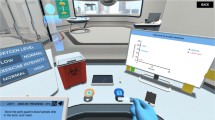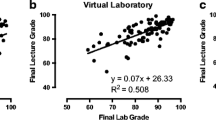Abstract
Laboratory education plays a prominent role in the education of engineers and scientists for the practical knowledge and research skill sets they impart. The cost of laboratory set up can vary in magnitudes depending on the level of sophisticated analysis they deliver. Added are the costs of maintenance and facility requirements. Recent advancements in technology enhanced laboratories such as virtual simulation based laboratory and remotely triggerable laboratories, both of which allow e-learning for laboratory education has shown to impact the laboratory education in a significant way. This paper focuses on comparing the tangible and intangible benefits of the various types of laboratories available to students today. Evaluating the differences in infrastructural set up, safety elements, equipment costs, the experimentation time and the effective learning from these laboratories are examined closely. Using pair wise correlation, the advantages and difficulties observed in chemistry based experiments are presented. The compromises, if any, using cost effective laboratories is investigated using N=141 students that underwent undergraduate education. Although most students use physical labs today, the growing trends in online and distance education makes this work significant to teachers and administrators alike. Although not an alternative, the scalability and functional proficiency these virtual laboratories allow bridging the gaps found in traditional laboratories.
Access this chapter
Tax calculation will be finalised at checkout
Purchases are for personal use only
Preview
Unable to display preview. Download preview PDF.
Similar content being viewed by others
References
Feisel, L.D., Albert, J.R.: The role of the laboratory in undergraduate engineering education. Journal of Engineering Education 94(1), 121–130 (2005)
Ma, J., Nickerson, J.V.: Hands-on, simulated, and remote laboratories: A comparative literature review. ACM Computing Surveys (CSUR) 38(3), 7 (2006)
Benetazzo, L., Bertocco, M., Ferraris, F., Ferrero, A., Offelli, C., Parvis, M., Piuri, V.: A Web-based distributed virtual educational laboratory. IEEE Transactions on Instrumentation and Measurement 49(2), 349–356 (2000)
Abdulwahed, M., Nagy, Z.K.: The TriLab, a novel ICT based triple access mode laboratory education model. Computers & Education 56(1), 262–274 (2011)
Tatli, Z., Ayas, A.: Virtual Chemistry Laboratory: Effect of Constructivist Learning Environment. Turkish Online Journal of Distance Education (TOJDE) 13(1) (2012)
Tüysüz, C.: The Effect of the Virtual Laboratory on Students’ Achievement and Attitude in Chemistry. International Online Journal of Educational Sciences 2(1) (2010)
Patterson, D.A.: Impact of a multimedia laboratory manual: Investigating the influence of student learning styles on laboratory preparation and performance over one semester. Education for Chemical Engineers 6(1), e10–e30 (2011)
Achuthan, K., Sreelatha, K.S., Surendran, S., Diwakar, S., Nedungadi, P., Humphreys, S., ... Mahesh, S.: The VALUE@ Amrita Virtual Labs Project: Using Web Technology to Provide Virtual Laboratory Access to Students. In: 2011 IEEE Global Humanitarian Technology Conference (GHTC), pp. 117–121. IEEE (October 2011)
Diwakar, S., Achuthan, K., Nedungadi, P., Nair, B.: Enhanced facilitation of biotechnology education in developing nations via virtual labs: analysis, implementation and case-studies. International Journal of Computer Theory and Engineering 3(1), 1–8 (2011)
Raman, R., Nedungadi, P., Achuthan, K., Diwakar, S.: Integrating collaboration and accessibility for deploying virtual labs using vlcap. International Transaction Journal of Engineering, Management, & Applied Sciences & Technologies 2(5) (2011)
Merchant, Z., Goetz, E.T., Cifuentes, L., Keeney-Kennicutt, W., Davis, T.J.: Effectiveness of Virtual Reality-based Instruction on Students’ Learning Outcomes in K-12 and Higher Education: A Meta-Analysis. Computer Education 70, 29–40 (2014)
Tatli, Z., Ayas, A.: Effect of a Virtual Chemistry Laboratory on Students’ Achievement. Journal of Educational Technology & Society 16(1) (2013)
Hanes, N., Lundberg, S.: E-learning as a Regional Policy Tool: Principles for a Cost-benefit Analysis. RUSC. Universities and Knowledge Society Journal 5(1) (2008)
Cohen, A., Nachmias, R.: Implementing a Cost Effectiveness Analyzer for Web-Supported Academic Instruction: A Campus Wide Analysis. European Journal of Open, Distance and E-Learning (2009)
Saaty, T.L.: How to make a decision: the analytic hierarchy process. European Journal of Operational Research 48(1), 9–26 (1990)
Zimmer, S., Klumpp, M., Abidi, H.: Industry Project Evaluation with the Analytic Hierarchy Process. In: 10th Annual Industrial Simulation Conference, pp. 4–6 (June 2012)
Author information
Authors and Affiliations
Corresponding author
Editor information
Editors and Affiliations
Rights and permissions
Copyright information
© 2015 Springer International Publishing Switzerland
About this paper
Cite this paper
Achuthan, K., Murali, S.S. (2015). A Comparative Study of Educational Laboratories from Cost & Learning Effectiveness Perspective. In: Silhavy, R., Senkerik, R., Oplatkova, Z., Prokopova, Z., Silhavy, P. (eds) Software Engineering in Intelligent Systems. Advances in Intelligent Systems and Computing, vol 349. Springer, Cham. https://doi.org/10.1007/978-3-319-18473-9_15
Download citation
DOI: https://doi.org/10.1007/978-3-319-18473-9_15
Publisher Name: Springer, Cham
Print ISBN: 978-3-319-18472-2
Online ISBN: 978-3-319-18473-9
eBook Packages: EngineeringEngineering (R0)




